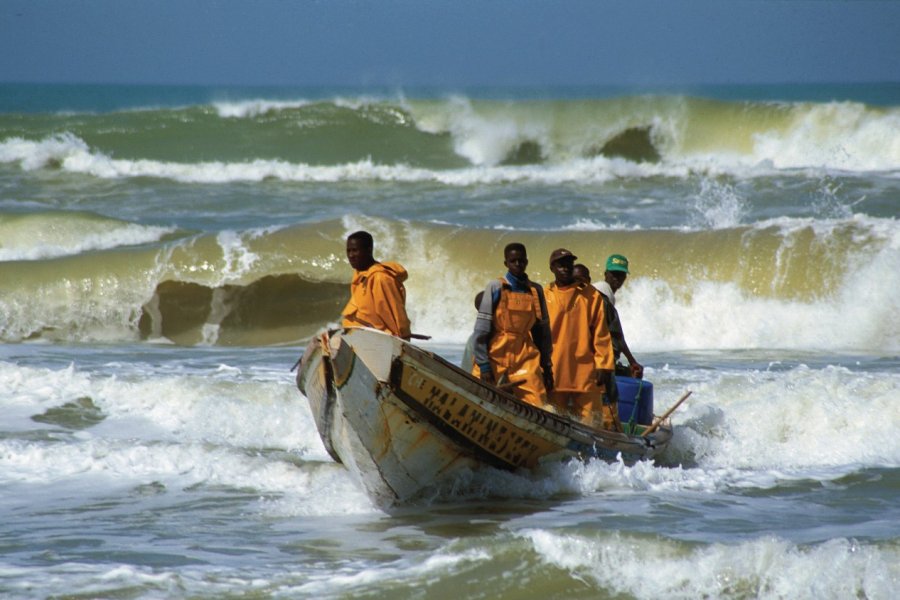Travel guide Senegal
Senegal's first president was Léopold Sédar Senghor, poet and academic. A poet president is a good symbol of Senegal, a country of music and griots, a country with incessant noise and multiple languages. If French is the national language, you can hear ethnic languages such as Wolof, Serere or Diola, languages as varied as the Senegalese landscapes, in the streets of Dakar and Saint-Louis, in the markets of Kermel and Soumbédioune and on the island of Fadiouth. From the desert of northern Senegal, to the "green" Casamance, passing through Dakar, the Petite côte, the Sine-Saloum, the Kaolack region and the Niokolo-Koba park, Senegal's landscapes and tourist attractions are numerous and unknown. It is true that apart from Saly, its beaches and resorts, and Gorée, the slave island, the destination lacks notoriety and much is gained by discovering this country of fishermen and pirogues, villages in the bush, and Sahelian deserts. Above all, it is worth testing the concept of teranga, this innate sense of hospitality that is rooted in the country's culture. Convinced? So, do not hesitate and go and visit, with your tourist guide from Senegal, this region "on the edge of Africa"...
What to see, what to do Senegal?
-
Book an activity
-
Customized travel
- The most beautiful cities Senegal
When to go Senegal ?
The weather is nice and dry almost all year round. Also the best time to visit Senegal is between November and June: the temperatures are ideal (especially between April and June) and you will not suffer too much from the heat at this time. This is certainly the best time to visit the natural areas and the big parks. Specifically, April and May for the animal reserves. Be aware that during the winter, the rainy season from July to October, the Djoudj National Park as well as the Niokolo Koba National Park are not very interesting. It is therefore not necessary to stroll in these areas for a long time during the summer. Also, the region of the Senegal River is unbearably hot during this period. However, the whole of Senegal does not lose its interest: if Tambacounda becomes a furnace during the rainy season, the Bedik and Bassari countries are covered with a unique green canvas at this time of the year. Casamance, a greener region, benefits from a longer rainy season, starting in April or May.
Suggested addresses Senegal
Travel Senegal
-
Find a hotel
-
Car Rental
-
International e-SIM package
-
Find a local agency
From the hectic capital to the picturesque city of Saint-Louis, via the bolongs of Sine-Saloum or Casamance and the country's animal reserves, Senegal offers a multitude of itineraries and possibilities for excursions that you would have to stay at least a month to discover all its riches. However, in about ten days, it will be possible for you to get a good overview of the Teranga country. The classic itinerary consists of discovering Dakar and the Cape Verde peninsula, spending a few days in the north of the country, having a good time on the Petite Côte and crossing the Sine-Saloum mangrove swamp in a pirogue. For those who have the time, Casamance and eastern Senegal are green regions where animist traditions have remained intact. And the Fouta-Toro, a trip back in time along the Senegal River. Although the option is expensive, renting a car will save you precious time.
Find unique Stay Offers with our Partners
How to go Senegal
How to go alone
It is advisable to book your accommodations in advance. This will greatly facilitate your trip. Although Senegal is generally a safe country (even if the Sahel and Casamance areas sometimes experience some unrest), do not forget that it is a poor country and that your wealth can attract greed: be vigilant. Having a local guide can be useful.
How to go on a tour
Stays on the beaches of Saly, cultural tours, discovery of typical villages, excursions in the desert, travel up the Senegal River... there are many organized trips to discover the country of Teranga. It is up to you to choose the option that suits you according to your budget, your desires and your availability.
How to get around
In Senegal, public transportation (in town or to connect towns) is not very reliable in terms of schedules and comfort. However, you can opt for the taxi-brousse or the fast bus to travel the African way. Cabs are very useful in the streets of Dakar (even if the traffic is often infernal). To leave Dakar, renting a car is often the most practical. Finally, pirogues are picturesque and frequent in Casamance and in the Sine-Saloum.
Featured articles Senegal
Discover Senegal
Originally a land of dislocated empires, Senegal saw its unification with French colonization, between wars and cooperation. Over time, the different ethnic groups established on its territory have learned to live together harmoniously, in exemplary harmony. This multi-ethnic country, with diverse religions and popular beliefs, is today a true cultural mosaic, with deeply rooted traditions. From popular festivals to animist ceremonies and religious pilgrimages, Senegal lives to the rhythm of a myriad of festivities throughout the year. Not to mention its international jazz festival, renowned beyond its borders for its eclectic programming, which takes place in the bewitching colonial city of Saint-Louis. The Senegalese have a real gift for crafts, from wooden sculptures to hand weaving, painting under glass and basketry.
Pictures and images Senegal
The 12 keywords Senegal
1. Peanut

From the roots to the leaves, the whole peanut plant is consumed in Senegal! We find its seeds in aperitif, roasted and salted, its leaves in the mafé sauce accompanying beef or mutton, its oil in the binders of soaps or its roots in medicinal herbal teas. In short, an essential product for Senegalese households!
2. Ataya

It designates the Senegalese people's favourite ritual, that of having tea with family or friends, around long discussions. A real moment of sharing and relaxation, where one takes the time to enjoy three glasses of mint tea. "The first is bitter like life, the second is strong like love and the last is sweet like death. Unbelievable!
3. Bolong
Specific to the ecosystem of the Sine-Saloum and Casamance regions, the bolong is an arm of the sea subject to the rhythms of the tides, which can sink up to 250 km inland. It is bordered by mangrove to mangrove swamps and its waters are rich in fish, oysters and cockles. It is also home to many species of birds.
4. Dibiterie
It is in these stalls, sometimes makeshift, that dibi, grilled meat is bought, generally mutton, but which is available according to availability. Well seasoned, it is served in bread, with onions and sometimes French fries. However beware of the tourista, these establishments are far from the recommended hygiene standards.
5. Karité

A common species in the savannahs of West Africa, the shea tree, which means "butter tree" in Wolof, grows in eastern Senegal, near Kédougou. Its nuts are used to make a very greasy butter, renowned for its moisturizing and nourishing properties. It is sold raw on the markets or used in cosmetic products.
6. Mbalax
Popularized in the 80s by Youssou N'dour, mbalax embodies the Senegalese musical identity. This highly distinctive and easily recognizable music mixes ternary rhythms and percussion, and is accompanied by frenzied dancing. In cabs, in nightclubs or at a popular party, mbalax is consumed without moderation!
7. Palabre
The palaver is a whole art of living in Senegal. In the shade of a big tree, we discuss the village's problems and try to solve them. Sometimes, these long discussions are idle, just to pass the time, to have tea. It also takes on the meaning of "tchatche" during negotiations, a technique to better convince.
8. Pirogue

The name of the country would come from the Wolof "sunu gal", our dugout canoe. These long boats, often dug out of a single tree trunk, are mainly used by fishermen, who overload them with fish. In Mbour, Kayar and Saint-Louis, their alignments offer a colourful snapshot and the return of the fishermen, a striking spectacle.
9. Greetings
Whether in Arabic, Wolof or French, greetings are of paramount importance in Senegal. To address someone without having greeted them is even a real affront! On the telephone, in the street and in offices, people are always asked if the person is well. News often drags on from family to work.
10. Teranga
A leitmotif throughout the country, teranga refers to Senegalese hospitality: humble, warm and generous. Much more than a value, it's a state of mind shared by all ethnic groups, in a desire to live together harmoniously. From a warm welcome to a wide range of invitations, the Senegalese know how to welcome you!
11. Tiep bou dien
It is the national dish of Senegal, listed as an intangible cultural heritage of humanity. Made of rice cooked in a tomato sauce, it is served with fish with a spicy stuffing and fresh vegetables, such as white cabbage and sweet potatoes. Often on the menu, it is eaten with friends or family, with a spoon or by hand.
12. Thiouraye
Incense based on bark, aromatic plants and resin, it is the weapon of seduction of Senegalese women, each of which has its own recipe! Their fragrances, musky and heady, quickly turn men's heads. Traditionally, thiouraye is used to embalm houses and clothes, but also for mystical purposes.
You are from here, if...
You know the son of your friend's wife's distant uncle's cousin, because here the network of relationships is so vast that you always have a common acquaintance, even 200 km away!
Talking in the shade of a baobab tree, with a glass of tea in your hand, has become your favourite pastime. Because, as you can imagine, you're among friends, discussing the latest news from the village all afternoon long.
At every street corner, you stop to greet your friends, and after a few hours, you still haven't arrived at your destination, because you have had to catch up on the news of your parents, business and the health of each of your friends, without forgetting anyone!
You let yourself be carried away by the unbridled rhythms of mbalax, even though you know that you are not up to the Senegalese people and that you risk making the whole assembly laugh!
You speak tuutu-tuuti wolof, and that it immediately becomes easier to negotiate, even with your strong accent!



































